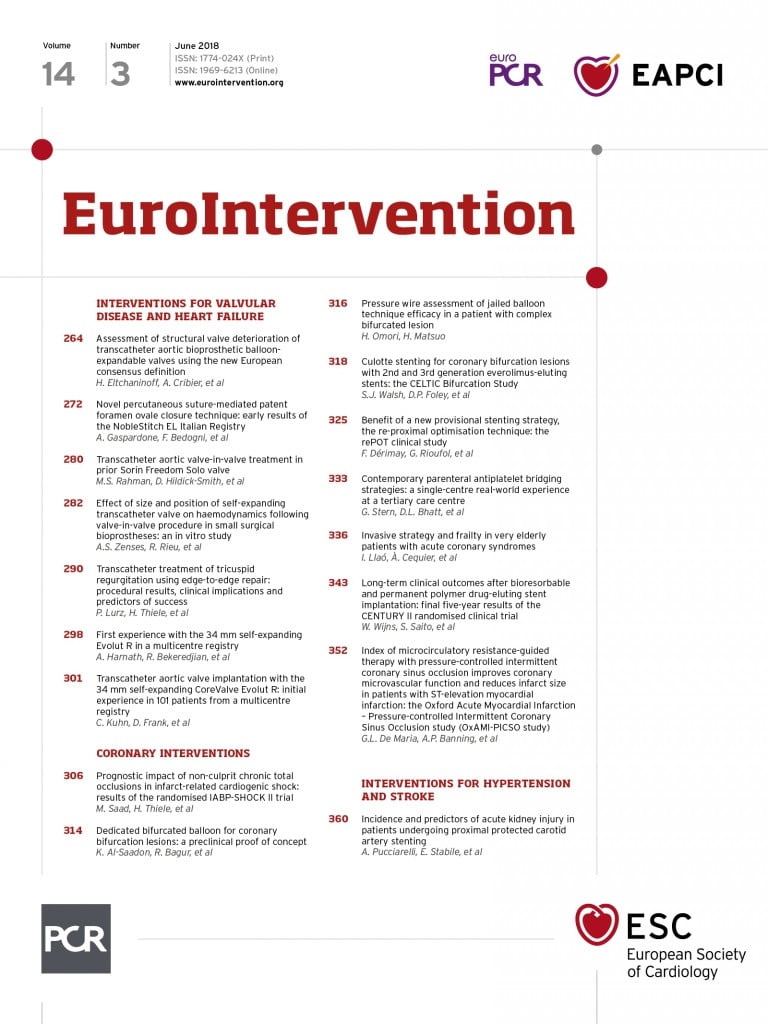
Even today, ST-segment elevation myocardial infarction (STEMI) complicated by cardiogenic shock (CS) remains associated with very high mortality1,2. There is currently only one positive randomised clinical trial in the setting of STEMI complicated by CS - the SHOCK (Should We Emergently Revascularize Occluded Coronaries for Cardiogenic Shock) trial - which showed a reduction in mortality with emergency revascularisation compared with initial medical stabilisation in CS patients3. Ever since SHOCK was published 20 years ago mortality rates in CS have remained stable at approximately 50%1-3. Multivessel disease is very common in patients with CS, with a prevalence of approximately 80%1. Prior observational studies have suggested that the presence of a chronic total occlusion (CTO) in a non-infarct-related artery (IRA) is a particularly strong predictor of mortality in patients with CS4,5. Such a CTO in an IRA is a relatively common finding with a reported prevalence of 25-30% in CS1,4,5.
In the current issue of EuroIntervention, Mohammed Saad et al report the prognostic impact of a CTO in a non-IRA in STEMI patients with CS from the IABP-SHOCK II (Intraaortic Balloon Pump in Cardiogenic Shock) trial and accompanying registry6.
In keeping with previous data, a CTO in a non-IRA was an independent predictor of one-year mortality (hazard ratio 1.30, 95% confidence interval: 1.02-1.67, p=0.03). Moreover, a CTO in a non-IRA was associated with increased rates of ventricular arrhythmias requiring defibrillation at 30-day follow-up. This last finding adds important insight into the potential mechanism of increased mortality in patients with a CTO after STEMI complicated by CS and is in line with several observational studies indicating a significantly higher rate of appropriate implantable cardioverter-defibrillator (ICD) therapies in patients who received an ICD for secondary prevention of sudden cardiac death7,8. Interestingly, a recent review and meta-analysis investigating electrocardiographic parameters after successful CTO PCI showed a significant reduction in QT dispersion, suggesting homogenisation in repolarisation which may theoretically improve electrical stability9.
Other mechanisms by which the presence of a CTO increases mortality include a lower baseline left ventricular ejection fraction (in the current study 30% in the CTO group vs. 39% in the group without a CTO, p<0.001) which can be explained by two mechanisms. Firstly, the presence of a CTO suggests a prior myocardial infarction. Secondly, the so-called “double jeopardy” hypothesis states that the myocardial territory supplied by the IRA is at increased risk as it has fewer functional residual vessels from which to receive collaterals while the myocardial territory supplied by the CTO may be dependent on collaterals from the IRA.
The present study once again underscores the important prognostic value of a CTO in the setting of CS but unfortunately does not provide us with answers to the question of how to improve outcomes in this high-risk group. The investigators report that there was no interaction between the presence of a CTO and randomised treatment allocation on mortality, confirming the results of the main study that there is no benefit associated with IABP use in patients with CS.
The optimal extent of revascularisation in the setting of primary PCI for STEMI complicated by CS remains a topic of intense debate. Until recently, expert opinion has favoured complete revascularisation in patients with ongoing instability10,11. However, the recent CULPRIT-SHOCK (Culprit Lesion Only PCI Versus Multivessel PCI in Cardiogenic Shock) trial showed no benefit with immediate complete revascularisation compared with culprit-lesion only PCI in STEMI patients with CS1. In fact, at 30-day follow-up the primary endpoint (death or renal replacement therapy) had occurred in 55.4% of patients in the multivessel PCI group as compared with 45.9% in the culprit-only group (p=0.01). Importantly, in CULPRIT-SHOCK, no interaction was observed between the presence of a CTO and randomised treatment allocation on the primary endpoint. Furthermore, even when performed by dedicated operators, CTO PCI remains associated with relatively low success rates and requires a lengthy procedure with considerable use of contrast medium and high risk of complications. Therefore, immediate non-culprit CTO PCI is currently poorly feasible with a low success rate and, most importantly, not beneficial with a higher rate of complications.
As mortality after STEMI complicated with CS remains as high today as it was 20 years ago, and interventions such as IABP and immediate complete revascularisation have failed, perhaps it is time for a paradigm shift in the treatment of CS. Early initiation of powerful mechanical circulatory support (such as extracorporeal membrane oxygenation) in CS patients may address the principal problem of inadequate organ perfusion. Subsequently, when haemodynamic stability is achieved, complete revascularisation may be attempted to preserve as much myocardium as possible. Of course, whether such an approach may finally reduce mortality after CS will need to be determined in a large-scale randomised clinical trial. Until that time, a prolonged attempt to revascularise a CTO during primary PCI for CS patients is neither safe nor feasible, and revascularisation of a CTO during follow-up should be dependent on viability, ischaemia, and symptoms.
Conflict of interest statement
The authors have no conflicts of interest to declare.

